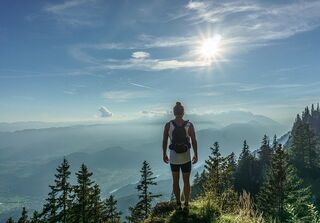Embarrassment
Lessons From Machu Picchu
The psychological journey from the valley to the mountaintop.
Posted December 22, 2020

This essay was first published in Womankind magazine, #026: Peru, 2020. Used with permission.
Dream big, take risks, reach for the stars. If we seek to have a mountain top experience, is this what we need to do to get there? Yes, indeed. Visualizing one’s hopes and dreams is critical to achieving them. Setting intentions and goals—imagining a more expansive life for ourselves—is an essential driving force in making our dreams come true.
But there is more to it than that. Or, said in another way, there is less to it than that. The path to the peak experience is far less grand than we might imagine. It is found in ordinary daily practice. The path is forged one step at a time, one breath at a time, one tiny success at a time. Often, it is a zig-zag path, a sawtooth pattern, a two-steps-forward one-step-back kind of journey. Peak experiences are reached through training with boots on the ground, hands in the dirt, minds engaged in overcoming challenges as they arise.
Think about Peru’s Machu Picchu, one of the seven wonders of the world. How did the Incas do it? Machu Picchu is celebrated as a wonder because of the brilliant engineers and architects that designed it—the city, the supporting terraces, the bridges, and more. It is wondrous that they could dream and envision it. But, to me, the greater wonder is that they could actually make it happen. They needed more than a vision. They needed to be masters at solving the puzzles of nature. They needed to put in the time to study all that was available to them and to experiment on a smaller scale. They needed to figure it out, piece by piece, until the puzzle was complete.

There is another wonder still, less theoretical and far more practical. The Incas built an elaborate city on the side of a mountain, stone by stone, without the help of computers, machinery, or construction vehicles—incredibly, they did it without mortar, wheels, or iron tools! Can you imagine it? Fifty-ton granite stones hauled up a mountain by hundreds of men, one piece at a time. Weeks and months and years of hand-chiseling the natural rock to create a structure that would support an entire city. That’s not magic, or a mystery, or a spiritual phenomenon. That is hard work, wondrous in its own important way.
There is a lesson for us, here in our post-modern world where it seems we can achieve so much with the click of a button. Instant gratification is an illusion. No great feat is realized without hard work, intelligently applied, and incrementally achieved over time. No one gets to the top of a mountain overnight, simply by luck or inheritance or even genius. And, in the rare case that one does (like winning the lottery), there is no lasting gain in the experience. Because it is not earned in the workshop of one’s daily efforts, sweat, and strain, its impact evaporates like condensation on a windshield. It is gone the minute things heat up.
Now this psychological model is true for all kinds of peak experiences, not just physical ones. Psychoanalyst Melanie Klein was famous for saying that the psyche does not grow by leaps and bounds; it grows bit by bit—from infancy to adulthood, from fear to security, from isolation to loving relationships. Maturity is built bit by bit. Character is built bit by bit. We develop some semblance of psychological mastery by putting in the time, learning from our failures, trying to put the puzzle pieces together, gaining strength through adversity, building mental and emotional muscle. Tolerance, patience, persistence, creativity, flexibility, and determination are the traits that will take us to the top of the mountain.
But many of us don’t make it there despite the fact that we have the basic building blocks—the talent, intelligence, and resources—to develop highly satisfying lives. We find ourselves thwarted, not so much by external factors but by internal ones. In my experiences in clinical practice and the wider frame of my life, I find that many of us are stymied by one or more of the following factors.
First, we have a mistaken belief that success is a straight-forward, easy path. We believe that most people don’t encounter difficulties along the way. We believe that the fact that we encounter difficulties means that something is wrong with us. In psychological terms, we idealize the success of others and devalue our own efforts as mediocre and trivial.
Second, we have trouble tolerating the experience of being beginners. We are paralyzed by feelings of shame and humiliation at smallness, confusion, and lack of knowledge. If we give up when we feel small, we foreclose on any opportunity to grow, improve, and move forward toward our goals.

Third, we tend to stick to what we know. This is a thorny psychological problem. It isn’t so much that we are lazy; we put in the hours and the effort but don’t see the results. This is very demoralizing. If we look deeper, we discover the underlying problem: We are doing the same things, over and over again. We keep pounding the square peg into the round hole, hoping that maybe this time it will work.
Finally, we invest too much time comparing ourselves to others. This is inevitably a dead end. We must learn to follow our own North Star, to invest in a life-long self-improvement process without so much concern for how we measure up to other people. Despite what all the fancy marketing tells and sells us, life is not a competition. A life of deep satisfaction is one which we determine for ourselves.
Those who are able to reach the mountain top experience are those who are able to spend a lot of time in the valley. The runner’s high comes at the sweet spot between comfortable effort and exhaustion. You break through the mundane, tedious, and painful experience of pounding the pavement, mile after mile, and for a short time find yourself in a state of exhilaration. Creative flow for the artist, musician, or writer arrives just before the moment of giving up, when you have worked so tirelessly with only modest results, working through feelings of failure and inadequacy. For the meditator, moments of deep inner peace are bookended by countless hours of sitting, persecuted by the monkey mind, following the breath through the oscillating process of losing and finding it again.

This is the paradox of the world’s great wonders. The mountain top experience is possible and has the potential to be life-changing only if we have the discipline for the daily grind. We have to put in the psychological and physical work to get to the summit. If the journey is easy, it won’t do a thing for us. If we want to get better at something, we have to practice the hardest parts. Often, the hardest parts are the most humbling ones. They require us to be more realistic, more patient, and more accepting of the trial-and-error, incremental nature of the journey itself. If we can humble ourselves enough to take on the mindset of a child, a student, an apprentice, an explorer, a regular flesh-and-blood human being, then we have a chance to do something and become something really special.




